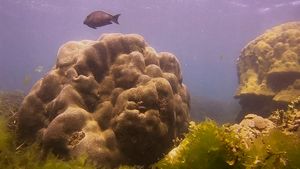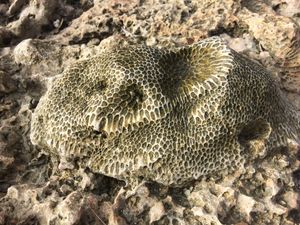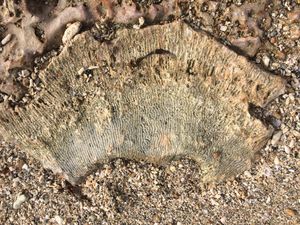Skiza Sea
2018
Skiza Sea_01_Production Still_2017_(c)Bauer-Hopkins-1
Chaperoning Coral Reefs - Justin Benesch
excerpt from Global Challenges Research Fund (GCRF) application
The overall objective of this short project (until August 2018) is to explore the possibilities for developing a partnership for longer- term, interdisciplinary, and international collaboration, based on understanding the stress response in coral at the molecular level, how it may be manipulated, and doing so in a way that engages with local communities.
Background:
Coral reefs are some of the most beautiful and diverse ecosystems on Earth, covering almost 300,000 square kilometres of our planet’s surface. Shallow-water reefs form almost exclusively between the tropics, latitudes that are also associated with economically underdeveloped countries. However, coral reefs represent a precious economic resource, generating $36 billion for the travel industry each year, with much of their potential still unrealised (Mar Policy, 2017, 82, p104-13). In addition, coral reefs underpin the livelihoods of many local communities, who depend on the health of the ocean for food and income. While valuable, the reefs are also vulnerable environments, with climate change and other anthropogenic causes leading to rising sea temperatures and acidity, and consequently loss of coral and the habitat for other organisms that they create. This impacts directly on local communities, and ultimately the development of the countries in which the reefs lie.
However, it is clear that corals can evolve resistance to temperature changes. For instance, it is possible for the same coral species to live at both geographical extremes of the Great Barrier Reef, in waters that are on average two degrees different in temperature, even though samples from both locations will bleach if the temperature varies from the local average (Front Mar Sci, 2015, 2, 68). Such observations, together with coral-breeding showing considerable potential for engineering resilient corals (Sci Rep, 2017, 7, 13985), reveals that there are molecular mechanisms at play that provide thermo-adaptation, likely through different genes or modulation of their expression levels.
Aims and objectives
The aim of this project is to pump-prime an interdisciplinary research partnership on coral stress tolerance, from molecules to reefs. By involving scientists, conservationists, artists, and local communities near the coral, the partnership would aim to explore molecular mechanisms by which corals respond to stress (and their specific manifestation in species found in reefs in developing world countries), and engage with and impact on the neighbouring communities. By being led by the ecological and societal particulars of the locations, this work is designed to have direct impact on the economic development of the countries involved.
2.1 Partnership
The priority is to assess the feasibility of establishing a lasting international partnership, with interdisciplinary experience, investigate the response to stress in corals at the molecular level, and to leverage that for economic development of the low income countries. We aim to involve members from academia, global and local NGOs, artists and community leaders, to provide a flexible and varied grouping with broad interests.
Objective 1: Build a group of participants, with varied expertise and approaches, and from different locations and institutions, for longer-term partnership.

Skiza Sea_01_Production Still_2017_(c)Bauer-Hopkins-1
2.2 Science
We have an initial scientific hypothesis, that we will investigate the expression and function of molecular chaperones in coral (see 4). On the timescale of this initial funding, the work will be carried out by the PDRA and we aim to involve samples collected from the field, in order to tailor the science to the genetic specificity of the coral at those locations. Objective 2: Define scientific direction and work-plan, testing initially our hypothesis that molecular chaperones are a key part of coral thermo-tolerance.
2.3 Impact
In order to translate the research into tangible benefit for the countries and local communities involved, we will disseminate the work in the developing world locations. While exchange of expertise between the partners will come naturally through association to the project, we will also disseminate the work explicitly, in ways we feel are most effective to each location, while supporting local research and activities directly. Objective 3: Engage the local communities with the research partnership and its work to inform on the “valuable but vulnerable” nature of coral reefs.
3 Project locations and potential partners
We propose an inter-disciplinary partnership between Oxford and locations in countries on the DAC list of ODA recipients2, as per the remit of GCRF funding. Our initial locations, at the time of applying for funding, were the Andaman and Nicobar Islands (India, “lower middle income country”), and the coast of Kenya (“low income”). We chose these two locations because of their coral and associated, continuing economic potential due to tourism (Mar Policy, 2017, 82, p104-13). In addition, coral specific to these regions had not, to the best of our knowledge, been subject to study at the molecular level.
The aim of this project is not however to be limited in scope, but instead these locations represent a starting point for information-gathering for the project. Below is a list of potential participants to cover the expertise and capabilities to meet our project objectives of performing scientific investigations on location-specific coral samples, building a broad and lasting partnership
3.1 Kenyan Coast
We have chosen two locations on the Kenyan coast, Watamu and Malindi. These sites have coral reefs that are recovering from a notorious bleaching event due to El Niño in 1998, highlighting their fragility, but also suggesting that the coral that has repopulated the reefs may have attributes that make it particularly resilient.
3.2 Andaman and Nicobar Islands
This isolated archipelago in the Bay of Bengal is bestowed with abundant marine resources. Chief amongst these are coral, found over the approximately 12000 km2 reef area, that has 80% of the global maximum for coral species (Government of India and United Nations Development Programme Global Environment Facility IND/95/G41: Conservation of the Coral Reef Ecosystem in the Andaman and Nicobar Islands, 2001, p76). This makes it an excellent location for us to establish a long-term relationship to investigate the presence, and diversity of molecular chaperone expression and function in coral.

Skiza Sea_02_Research Image_2017_(c)Bauer-Hopkins-1
Specific scientific hypothesis
Most organisms have a “stress response”, through which they act upon abiotic stresses such as temperature change (Mol Cell, 2010, 40, 253-266). Amongst these is the synthesis of “molecular chaperones”, which help to stabilise the proteins in the cell, preventing their unwanted, toxic aggregation and accumulation (Nature, 2011, 475, p324-32). Typically, the molecular chaperones most up-regulated under times of stress are the small heat-shock proteins (sHSPs), amounting often to more than 10% of the cell’s total protein component. A considerable body of work exists characterising the expression and function of sHSPs in vertebrates and plants, revealing their mechanism of action being to intercept proteins that become unfolded during heat shock, and later releasing them for either refolding, or regulated degradation (Trends Biochem Sci, 2012, 37, p106-17). This important role as “paramedics of the cell” means that sHSPs are key to organismal stress-tolerance, and ideal targets for manipulation.
From the few coral genomes that have been sequenced, it is clear that they contain molecular chaperones including sHSPs, and that these are produced by the organisms under conditions of elevated temperature (Proc Natl Acad Sci USA, 2013, 110, p1387-92). Despite this preliminary evidence, molecular chaperones and sHSPs in particular, have not been studied to any significant extent in corals. The scientific hypothesis underpinning this proposal is that molecular chaperones are key instruments in allowing corals to accommodate the quotidian and seasonal variations in water temperature they withstand, and provide a natural mechanism for thermo-tolerance that could be leveraged to assist against the threat of increasing sea temperatures and other abiotic stresses. Our overall goal is therefore to investigate this hypothesis, based on corals from specific developing-world locations, while directly engaging local scientists, conservationists, and the surrounding community.

Skiza Sea_02_Research Image_2017_(c)Bauer-Hopkins-12
download text as PDF